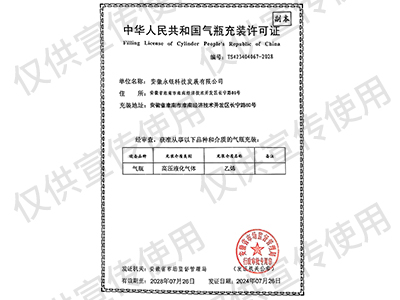Organic gas
![]()
Chemical Formula: C4H10
Structural Formula: CH3CH2CH2CH3
Purity: ≥99.5%
Packaging specifications
Cylinder specifications
Net gas volume
118L steel cylinder
60kg
400L steel cylinder
200kg
800L steel cylinder
400kg
926L steel cylinder
470kg
1、Basic physical properties
Chinese name
正丁烷
Melting point
-138℃
Alias
butane
Boiling point
-0.5℃
Chemical formula
C4H10
Density
2.48kg/m³(gas)
Molecular weight
58.122
Appearance
Colorless gas
CAS Registry Number
106-97-8
Security Description
S9;S16
EINECS login number
203-448-7
Hazard symbol
F+
-
-
Hazard description
R12
2、Source of n-butane
(1) Petroleum processing processPetroleum refining:In the process of petroleum refining,hydrocarbons with different carbon chain lengths can be separated from petroleum through fractional distillation.N-Butane,as a relatively light hydrocarbon,is usually separated in appropriate fractions.For example,in the distillation tower of a refinery,n-butane can be extracted from the fractions of crude oil based on the boiling point differences of different hydrocarbons.
Catalytic cracking and thermal cracking:In these processes,heavy petroleum fractions undergo cracking reactions at high temperatures and under the action of catalysts,producing various small molecule hydrocarbons,which may include n-butane.
(2) Natural gas processing
In addition to the main component methane,natural gas may also contain small amounts of n-butane and other hydrocarbons.Through gas separation and purification technology,n-butane can be extracted from natural gas.For example,using low-temperature separation technology,n-butane is separated from other gases by utilizing the condensation characteristics of different gases at different temperatures.
(3) Chemical production process
Ethylene production:In the process of ethylene production,hydrocarbon raw materials such as naphtha are usually subjected to steam cracking.This process generates a large amount of important chemical raw materials such as ethylene and propylene,as well as some by-products,including n-butane.N-Butane can be obtained from the cracking products through subsequent separation and purification steps.
Butadiene production:Butadiene is an important synthetic rubber and plastic raw material,and one of its production methods is through the oxidative dehydrogenation reaction of n-butane.In this process,n-butane reacts with oxygen under the action of a catalyst to produce butadiene and water.After the reaction,the product can be separated and purified to obtain high-purity butadiene,while also recovering unreacted n-butane.
(4) Biological process
Biomass fermentation:Certain microorganisms can undergo fermentation reactions under specific conditions,converting carbohydrates in biomass into gaseous products,which may contain small amounts of n-butane.For example,some anaerobic bacteria can produce mixed gases during fermentation,including methane,carbon dioxide,and small amounts of low-carbon alkanes such as n-butane.
3、Main purpose
Fuel:n-Butane is commonly used as a fuel,especially in household heating,cooking,and industrial heating.
Organic synthesis:n-Butane is an important organic synthesis raw material that can be dehydrogenated to produce butene or butadiene,isomerized to produce isobutane,and further catalytically oxidized to produce compounds such as maleic anhydride,acetic acid,acetaldehyde,etc.
Solvent and refrigerant:n-Butane is also commonly used as a solvent and refrigerant,especially in applications that require low-temperature environments.
Standard gas and calibration gas:Due to its stable chemical properties,n-butane is commonly used for instrument calibration and preparation of standard gases.
Other applications:n-Butane can also be used to prepare compounds such as hydrogen,halogenated butane,nitrobutane,and used as a wax precipitation solvent,resin foaming agent,etc.in oil wells.





